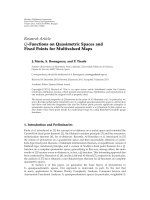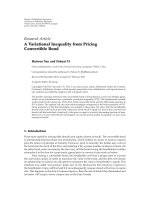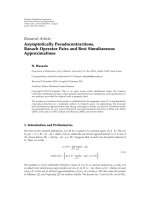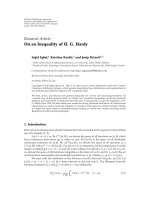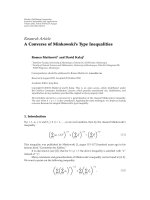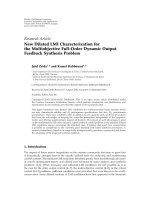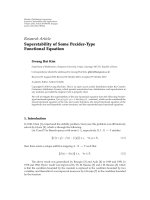báo cáo hóa học:" Research Article New Approach to q-Euler Numbers and Polynomials" ppt
Bạn đang xem bản rút gọn của tài liệu. Xem và tải ngay bản đầy đủ của tài liệu tại đây (487.92 KB, 9 trang )
Hindawi Publishing Corporation
Advances in Difference Equations
Volume 2010, Article ID 431436, 9 pages
doi:10.1155/2010/431436
Research Article
New Approach to q-Euler Numbers
and Polynomials
Taekyun Kim,
1
Lee-Chae Jang,
2
Young-Hee Kim,
1
and Seog-Hoon Rim
3
1
Division of General Education-Mathematics, Kwangwoon University, Seoul 139-701, South Korea
2
Department of Mathematics and Computer Science, Konkuk University, Chungju 380-701, South Korea
3
Department of Mathematics Education, Kyungpook National University, Taegu 702-701, South Korea
Correspondence should be addressed to Young-Hee Kim,
Received 11 January 2010; Accepted 14 March 2010
Academic Editor: Binggen Zhang
Copyright q 2010 Taekyun Kim et al. This is an open access article distributed under the Creative
Commons Attribution License, which permits unrestricted use, distribution, and reproduction in
any medium, provided the original work is properly cited.
We give a new construction of the q-extensions of Euler numbers and polynomials. We present new
generating functions which are related to the q-Euler numbers and polynomials. We also consider
the generalized q-Euler polynomials attached to Dirichlet’s character χ and have the generating
functions of them. We obtain distribution relations for the q-Euler polynomials and have some
identities involving q-Euler numbers and polynomials. Finally, we derive the q-extensions of zeta
functions from the Mellin transformation of these generating functions, which interpolate the q-
Euler polynomials at negative integers.
1. Introduction
Let C be the complex number field. We assume that q ∈ C with |q| < 1 and that the q-number
is defined by x
q
1 − q
x
/1 − q in this paper.
Recently, many mathematicians have studied for q-Euler and q-Bernoulli polynomials
and numbers see 1–18. Specially, there are papers for the q-extensions of Euler
polynomials and numbers approaching with two kinds of viewpoint among remarkable
papers see 7, 10. It is known that the Euler polynomials are defined by 2/e
t
1e
xt
∞
n0
E
n
xt
n
/n!,for|t| <π,andE
n
E
n
0 are called the nth Euler numbers. The
recurrence formula for the original Euler numbers E
n
is as follows:
E
0
1,
E 1
n
E
n
0, if n>0 1.1
2 Advances in Difference Equations
see 7, 10.Asfortheq-extension of the recurrence formula for the Euler numbers, Kim 10
had the following recurrence formula:
E
∗
0,q
2
q
2
, and
qE
∗
1
n
E
∗
n,q
⎧
⎨
⎩
2
q
if n 0,
0ifn ≥ 1,
1.2
with the usual convention of replacing E
∗
n
by E
∗
n,q
. Many researchers have made a wider
and deeper study of the q-number up to recently see 1–18. In the field of number theory
and mathematical physics, zeta functions and l-functions interpolating these numbers in
negative integers have been studied by Cenkci and Can 3,Kim4–12, and Ozden et al.
16–18.
This research for q-Euler numbers seems to be motivated by Carlitz who had
constructed the q-Bernoulli numbers and polynomials for the first time. In 1, 2, Carlitz
considered the recurrence formulae for the q-extension of the Bernoulli numbers as follows:
B
0,q
1,
qB 1
k
− B
k,q
⎧
⎨
⎩
1ifk 1,
0ifk>1,
1.3
with the usual convention of replacing B
k
by B
k,q
. These numbers diverge when q 1, and so
Carlitz modified and constructed them as following:
β
0,q
1,q
qβ 1
k
− β
k,q
⎧
⎨
⎩
1ifk 1,
0ifk>1,
1.4
with the usual convention of replacing β
k
by β
k,q
. From this, it was shown that lim
q → 1
β
k,q
B
k
.HereB
k
are the Bernoulli numbers.
Lately, Carlitz’s q-Bernoulli numbers have been studied actively by many mathemati-
cians in the field of number theory, discrete mathematics, analysis, mathematical physics, and
so on see 3–18.
The purpose of this paper is to give a new construction of the q-extensions of
Euler numbers and polynomials. It is expected that new constructed q-Euler numbers and
polynomials in this paper are more useful to be applied to various areas related to number
theory. In this paper, we present new generating functions which are related to q-Euler
numbers and polynomials. We also consider the generalized q-Euler polynomials attached to
Dirichlet’s character χ with an odd conductor and have the generating functions of them. We
obtain distribution relations for the q-Euler polynomials, and have some identities involving
the q-Euler numbers and polynomials. Finally, we derive the q-extensions of zeta functions
from the Mellin transformation of these generating functions. Using the Cauchy residue
theorem and Laurent series, we show that these q-extensions of zeta functions interpolate
the q-Euler polynomials at negative integers.
Advances in Difference Equations 3
2. New Approach to q-Euler Numbers and Polynomials
Let N be the set of natural numbers and Z
N ∪{0}. For q ∈ C with |q| < 1, let us define the
q-Euler polynomials E
n,q
x as follows:
F
q
t, x
2
∞
m0
−1
m
e
mx
q
t
∞
n0
E
n,q
x
t
n
n!
·
2.1
Note that
lim
q → 1
F
q
t, x
2
e
t
1
e
xt
∞
n0
E
n
x
t
n
n!
, for
|
t
|
<π,
2.2
where E
n
x are called the nth Euler polynomials. In the special case x 0, E
n,q
E
n,q
0 are
called the nth q-Euler numbers. That is,
F
q
t
F
q
t, 0
2
∞
m0
−1
m
e
m
q
t
∞
n0
E
n,q
t
n
n!
·
2.3
From 2.1 and 2.3,wenotethat
F
q
t, 1
F
q
t
e
t
F
q
qt
F
q
t
∞
l0
t
l
l!
∞
m0
q
m
E
m,q
t
m
m!
∞
n0
E
n,q
t
n
n!
∞
n0
nlm
n
l0
n!q
l
E
l,q
l!
n − l
!
t
n
n!
∞
n0
E
n,q
t
n
n!
∞
n0
n
l0
n
l
q
l
E
l,q
t
n
n!
∞
n0
E
n,q
t
n
n!
.
2.4
From 2.1 and 2.3, we can easily derive the following equation:
F
q
t, 1
F
q
t
2. 2.5
By 2.4 and 2.5,weseethatE
0,q
1and
n
l0
n
l
q
l
E
l,q
E
n,q
⎧
⎨
⎩
2ifn 0,
0ifn>0.
2.6
Therefore, we obtain the following theorem.
4 Advances in Difference Equations
Theorem 2.1. For n ∈ Z
, one has
E
0,q
1,
qE 1
n
E
n,q
⎧
⎨
⎩
2 if n 0,
0 if n>0,
2.7
with the usual convention of replacing E
i
by E
i,q
.
Theorem 2.1 of this paper seems to be more interesting and valuable than the q-Euler
numbers which are introduced in 7, 10.
From 2.1,wenotethat
F
q
t, x
e
x
q
t
F
q
q
x
t
∞
n0
n
l0
n
l
q
lx
x
n−l
q
E
l,q
t
n
n!
. 2.8
Therefore, we obtain the following theorem.
Theorem 2.2. For n ∈ Z
, one has
E
n,q
x
n
l0
n
l
x
n−l
q
q
lx
E
l,q
. 2.9
By 2.1,weseethat
F
q
t, x
∞
n0
2
∞
m0
−1
m
m x
n
q
t
n
n!
∞
n0
2
1 − q
n
n
l0
n
l
−1
l
q
lx
1
1 q
l
t
n
n!
.
2.10
By 2.1 and 2.10, we obtain the following theorem.
Theorem 2.3. For n ∈ Z
, one has
E
n,q
x
2
1 − q
n
n
l0
n
l
−1
l
q
lx
1
1 q
l
. 2.11
From 2.1, we can derive that, for f ∈ N with f ≡ 1 mod2,
F
q
t, x
f−1
a0
−1
a
F
q
f
t
f
q
,
x a
f
·
2.12
Advances in Difference Equations 5
By 2.12,weseethat,forf ∈ N with f ≡ 1 mod2,
∞
n0
E
n,q
x
t
n
n!
∞
n0
⎛
⎝
f
n
q
f−1
a0
−1
a
E
n,q
f
x a
f
⎞
⎠
t
n
n!
. 2.13
Therefore, we obtain the following theorem.
Theorem 2.4 Distribution relation for E
n,q
x. For n ∈ Z
, f ∈ N with f ≡ 1 mod2, one has
E
n,q
x
f
n
q
f−1
a0
−1
a
E
n,q
f
x a
f
.
2.14
By 2.1, we observe the following equations:
F
q
t, n
F
q
t
2
n−1
l0
−1
l
e
l
q
t
if n odd,
F
q
t, n
− F
q
t
2
n−1
l0
−1
l−1
e
l
q
t
if n even.
2.15
By 2.15, we obtain the following result.
Theorem 2.5. Let n ∈ N with n ≡ 1 mod2. Then one has
E
m,q
n
E
m,q
2
n−1
l0
−1
l
l
m
q
,
2.16
where m ∈ Z
.
Let χ be Dirichlet’s character with an odd conductor f ∈ N. Then we define the
generalized q-Euler polynomials attached to χ as follows:
F
q,χ
t, x
2
∞
m0
χ
m
−1
m
e
mx
q
t
∞
n0
E
n,χ,q
x
t
n
n!
.
2.17
6 Advances in Difference Equations
In the special case x 0, E
n,χ,q
E
n,χ,q
0 are called the nth generalized q-Euler numbers
attached to χ. Thus the generating functions of the generalized q-Euler numbers attached to
χ are as follows:
F
q,χ
t
2
∞
m0
χ
m
−1
m
e
m
q
t
∞
n0
E
n,χ,q
t
n
n!
.
2.18
By 2.1 and 2.17,weseethat
F
q,χ
t, x
f−1
a0
−1
a
χ
a
F
q
f
t
f
q
,
x a
f
∞
n0
⎛
⎝
f
n
q
f−1
a0
−1
a
χ
a
E
n,q
f
x a
f
⎞
⎠
t
n
n!
.
2.19
Therefore, we obtain the following theorem.
Theorem 2.6. For n ∈ Z
, f ∈ N with f ≡ 1 mod2, one has
E
n,χ,q
x
f
n
q
f−1
a0
−1
a
χ
a
E
n,q
f
x a
f
.
2.20
By 2.17 and 2.18,weseethat
F
q,χ
t, x
e
x
q
t
F
q,χ
q
x
t
∞
n0
n
l0
n
l
q
lx
x
n−l
q
E
l,χ,q
t
n
n!
. 2.21
Hence
E
n,χ,q
x
n
l0
n
l
q
lx
x
n−l
q
E
l,χ,q
. 2.22
From 2.17,wenotethat
F
q,χ
t, x
∞
n0
⎛
⎜
⎝
2
1 − q
n
f−1
a0
−1
a
χ
a
n
l0
n
l
−1
l
q
lxa
1 q
lf
⎞
⎟
⎠
t
n
n!
. 2.23
Advances in Difference Equations 7
From 2.17 and 2.23, we have
E
n,χ,q
x
2
1 − q
n
f−1
a0
−1
a
χ
a
n
l0
n
l
−1
l
q
lxa
1 q
lf
2
∞
m0
χ
m
−1
m
m x
n
q
.
2.24
In 2.19,itiseasytoshowthat
lim
q → 1
F
q,χ
t, x
⎛
⎝
2
f−1
a0
−1
a
χ
a
e
at
e
ft
1
⎞
⎠
e
xt
∞
n0
E
n,χ
x
t
n
n!
, 2.25
where E
n,χ
x are called the nth generalized Euler polynomials attached to χ.
For s ∈ C, we now consider the Mellin transformation for the generating function of
F
q
t, x.Thatis,
1
Γ
s
∞
0
F
q
−t, x
t
s−1
dt 2
∞
n0
−1
n
n x
s
q
,
2.26
for s ∈ C,andx
/
0, −1, −2,
From 2.26, we define the zeta function as follows:
ζ
∗
s, x
∞
n0
−1
n
n x
s
q
,s∈ C,x
/
0, −1, −2,
2.27
Note that ζ
∗
s, x is analytic function in whole complex s-plane. Using the Laurent series and
the Cauchy residue theorem, we have
ζ
∗
−n, x
E
n,q
x
, for n ∈ Z
. 2.28
By the same method, we can also obtain the following equation:
1
Γ
s
∞
0
F
q,χ
−t, x
t
s−1
dt 2
∞
n0
χ
n
−1
n
n x
s
q
.
2.29
For s ∈ C, we define Dirichlet type q-l-function as
l
q
s, x | χ
2
∞
n0
χ
n
−1
n
n x
s
q
,
2.30
8 Advances in Difference Equations
where x
/
0, −1, −2, Note that l
q
s, x | χ is also holomorphic function in whole complex
s-plane. From the Laurent series and the Cauchy residue theorem, we can also derive the
following equation:
l
q
−n, x | χ
E
n,χ,q
x
, for n ∈ Z
. 2.31
Remark 2.7. It is easy to see that
E
n,q
x
Z
p
x y
n
q
dμ
−1
y
,
E
n,X,q
x
X
x y
n
q
X
y
dμ
−1
y
,
2.32
see 19, Lemma 1.
Acknowledgment
The present research has been conducted by the Research Grant of Kwangwoon University
in 2010.
References
1 L. Carlitz, “q-Bernoulli numbers and polynomials,” Duke Mathematical Journal, vol. 15, pp. 987–1000,
1948.
2 L. Carlitz, “q-Bernoulli and Eulerian numbers,” Transactions of the American Mathematical Society, vol.
76, pp. 332–350, 1954.
3 M. Cenkci and M. Can, “Some results on q-analogue of the Lerch zeta function,” Advanced Studies in
Contemporary Mathematics, vol. 12, no. 2, pp. 213–223, 2006.
4 T. Kim, “On a q-analogue of the p-adic log gamma functions and related integrals,” Journal of Number
Theory, vol. 76, no. 2, pp. 320–329, 1999.
5 T. Kim, “q-generalized Euler numbers and polynomials,” Russian Journal of Mathematical Physics, vol.
13, no. 3, pp. 293–298, 2006.
6 T. Kim, “q-Euler numbers and polynomials associated with p-adic q-integrals,” Journal of Nonlinear
Mathematical Physics, vol. 14, no. 1, pp. 15–27, 2007.
7 T. Kim, “On the q-extension of Euler and Genocchi numbers,” Journal of Mathematical Analysis and
Applications, vol. 326, no. 2, pp. 1458–1465, 2007.
8 T. Kim, “q-extension of the Euler formula and trigonometric functions,” Russian Journal of
Mathematical Physics, vol. 14, no. 3, pp. 275–278, 2007.
9 T. Kim, “On the multiple q-Genocchi and Euler numbers,” Russian Journal of Mathematical Physics, vol.
15, no. 4, pp. 481–486, 2008.
10 T. Kim, “The modified q-Euler numbers and polynomials,” Advanced Studies in Contemporary
Mathematics, vol. 16, no. 2, pp. 161–170, 2008.
11 T. Kim, “Note on the Euler q
-zeta functions,” Journal of Number Theory, vol. 129, no. 7, pp. 1798–1804,
2009.
12 T. Kim, “A note on the generalized q-Euler numbers,” Proceedings of the Jangjeon Mathematical Society,
vol. 12, no. 1, pp. 45–50, 2009.
13 Y H. Kim and K W. Hwang, “Symmetry of power sum and twisted Bernoulli polynomials,”
Advanced Studies in Contemporary Mathematics, vol. 18, no. 2, pp. 127–133, 2009.
14 Y H.Kim,W.Kim,andL C.Jang,“Ontheq-extension of Apostol-Euler numbers and polynomials,”
Abstract and Applied Analysis, vol. 2008, Article ID 296159, 10 pages, 2008.
Advances in Difference Equations 9
15 Y H. Kim, W. Kim, and C. S. Ryoo, “On the twisted q-Euler zeta function associated with twisted
q-Euler numbers,” Proceedings of the Jangjeon Mathematical Society, vol. 12, no. 1, pp. 93–100, 2009.
16 H. Ozden, I. N. Cangul, and Y. Simsek, “Remarks on q-Bernoulli numbers associated with Daehee
numbers,” Advanced Studies in Contemporary Mathematics, vol. 18, no. 1, pp. 41–48, 2009.
17 H. Ozden and Y. Simsek, “A new extension of q-Euler numbers and polynomials related to their
interpolation functions,” Applied Mathematics Letters, vol. 21, no. 9, pp. 934–939, 2008.
18 H. Ozden, Y. Simsek, S H. Rim, and I. N. Cangul, “A note on p-adic q-Euler measure,” Advanced
Studies in Contemporary Mathematics, vol. 14, no. 2, pp. 233–239, 2007.
19 T. Kim, “Some identities on the q-Euler polynomials of higher order and q-stirling numbers by the
fermionic p-adic integral on
Z
p
,” Russian Journal of Mathematical Physics, vol. 16, pp. 484–491, 2009.

